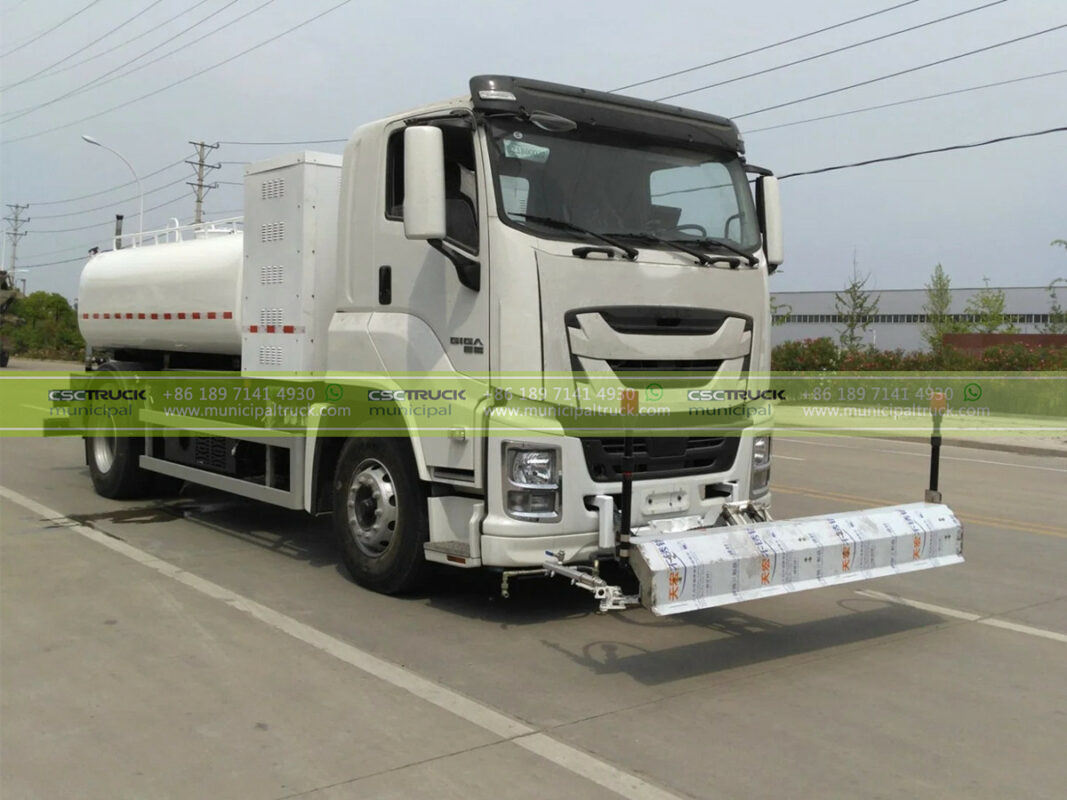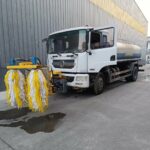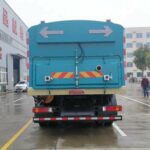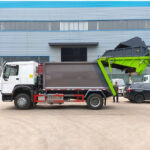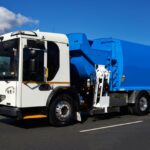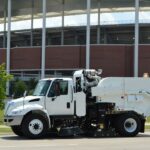Introduction: The Power Behind the Clean
While the rotating brooms of a road sweeper truck are the most visible component, capturing the public’s attention as they whirl and gather debris, the true powerhouse enabling effective large-scale cleaning lies hidden within the machine: the vacuum system. This sophisticated network of components is not merely an auxiliary feature; it is the critical mechanism responsible for the final and most important step – lifting collected material off the pavement and containing it securely within the hopper. Without a robust and efficient vacuum system, even the most aggressively sweeping brooms would merely redistribute dirt rather than remove it. Understanding the engineering principles, key components, operational parameters, and specialized adaptations of this system reveals the remarkable complexity behind what seems like a simple act of suction. This deep dive explores the anatomy and function of the vacuum system, the cornerstone of modern mechanical sweeping technology essential for maintaining clean urban environments, industrial sites, and critical infrastructure like airfields.
Core Components – Anatomy of the Vacuum
The vacuum system operates as a cohesive unit, with each part playing a vital role in generating, directing, and controlling the airflow necessary for debris collection. Its primary components include:
- Impeller/Fan: The heart of the system. This high-speed, multi-bladed centrifugal fan, typically powered directly by the truck’s power take-off (PTO) or a dedicated hydraulic motor, is responsible for creating the powerful airflow. As it rotates at high RPMs, it draws air in axially through its center and expels it radially outward at high velocity and pressure. This action creates a significant pressure drop (vacuum) at the intake side of the system.
- Ductwork and Hoses: This network forms the critical airflow path. Large-diameter, often flexible hoses connect the suction head or broom enclosure near the ground to the main suction manifold. Rigid ductwork then channels the air-debris mixture from the manifold towards the hopper and the impeller inlet. The design prioritizes minimizing bends and restrictions to maintain optimal air velocity and reduce turbulence that can cause material drop-out within the ducts. Seals at junctions are paramount to prevent air leaks, which directly degrade vacuum power.
- Suction Head/Enclosure: Positioned strategically over the brooms or directly behind them, this component shapes the airflow at the critical point of debris pickup. It creates a defined pickup zone where the high-velocity air stream generated by the impeller’s vacuum effect converges with the material dislodged by the brooms. The geometry of this head is meticulously designed to maximize the Venturi effect, accelerating air over the debris pile to efficiently lift and entrain particles of varying sizes and densities into the airstream. Effective sealing against the ground is crucial to prevent air bypass, ensuring maximum suction force is applied directly to the debris.
- Hopper: Serving as the primary collection chamber, the hopper is more than just a bin; it’s an integral part of the vacuum circuit. Air carrying entrained debris enters the hopper, typically through a manifold designed to distribute the flow. The sudden expansion in volume within the hopper causes the air velocity to drop precipitously. This rapid deceleration, often aided by strategically placed baffles or curtains, allows gravity to take effect. Heavier debris particles lose their momentum and fall out of suspension, settling to the bottom of the hopper. The now (relatively) cleaner air then continues its journey towards the impeller inlet.
- Filtration System: Positioned after the hopper but before the impeller inlet, the filtration system is the guardian of the fan and the environment. Its primary role is to capture the fine particulate matter (dust, silt, microplastics) that remains airborne after the initial separation in the hopper. Preventing this abrasive dust from reaching the impeller blades is essential to minimize wear and maintain fan efficiency. Equally important, high-efficiency filtration ensures that the air finally expelled from the truck (usually via an exhaust stack) meets stringent emission control and air quality regulations, preventing visible dust plumes and protecting public health and the environment.
The Physics of Pickup – Aerodynamics in Action
The fundamental principle governing debris collection is the movement of air from an area of higher pressure (the atmosphere) to an area of lower pressure (created by the impeller). This pressure differential generates the suction force. However, lifting and transporting debris involves complex fluid dynamics:
- Entrainment and Transportation: Debris is lifted and carried primarily through entrainment. The high-velocity airstream flowing over the debris pile creates shear forces that overcome the weight and adhesion of particles to the pavement. Once airborne, particles are carried within the airstream through the ductwork. The air velocity must be carefully calibrated – too low, and heavier or damp material won’t be lifted effectively; too high, and excessive energy is consumed, potentially causing abrasive wear in the ducts and fan, and potentially re-suspending dust within the hopper. Maintaining sufficient velocity throughout the system, especially around bends and through filters, is crucial to prevent material settling and blockages.
- Separation Dynamics in the Hopper: As the air-debris mixture enters the large volume of the hopper, its velocity drops sharply. This reduction in kinetic energy allows gravitational forces to dominate. Larger, heavier particles fall out of suspension first. Baffles or curtains disrupt the airflow pattern, creating eddies and further reducing the air’s carrying capacity, forcing smaller particles to drop. This process, known as inertial separation, relies heavily on the density and size of the particles relative to the air. The design aims for maximum debris fallout before the air reaches the filtration stage. The efficiency of this primary separation directly impacts the load on the filters and the overall system performance.
The Critical Role of Advanced Filtration
Modern sweeper filtration is a sophisticated barrier essential for operational longevity and environmental compliance. It typically employs a multi-stage approach:
- Pre-Cleaners/Cyclonic Separators (Optional but Common): Some systems incorporate an initial stage before the main filters, often using cyclonic action. By introducing a vortex, heavier dust particles are flung outward by centrifugal force and collected in a separate chamber or directed back towards the hopper, significantly reducing the particulate load reaching the primary filter media. This extends filter life and reduces maintenance frequency.
- Primary Filters: These are the workhorses, usually large cylindrical or panel filters made from pleated, high-efficiency synthetic media. They capture the vast majority of remaining fine dust (often down to 1-5 microns). Their large surface area is essential to handle the high volumetric airflow without causing excessive restriction. Filter efficiency, measured by standards like MERV or HEPA-equivalent ratings, is paramount for emission control. Modern filters often incorporate surface treatments (e.g., nanofibers) or electrostatic charges to enhance fine particle capture.
- Reverse Pulse Cleaning: To maintain airflow and prevent premature clogging, primary filters are equipped with an automatic cleaning mechanism. Compressed air pulses are fired in short bursts backwards through the filter media, dislodging accumulated dust cake into a collection tray or back into the hopper. This system operates on timers or differential pressure sensors, pulsing only when needed to optimize cleaning and minimize compressed air consumption. Effective pulse cleaning is vital for sustaining system performance over long operating periods.
Optimizing Performance – Key Operational Parameters
Achieving peak vacuum system efficiency requires careful management and understanding of several interdependent factors:
- Airflow Volume and Velocity: These are the primary metrics of suction power. Airflow volume (measured in CFM or m³/h) determines the total amount of air moved, influencing the size of the pickup area effectively covered. Air velocity (measured in FPS or m/s) determines the kinetic energy available to lift and entrain debris. Higher velocity is needed for heavier or wet material but consumes more power and increases wear. The system design aims for the optimal balance, ensuring sufficient velocity at the pickup point without unnecessary energy waste elsewhere. Monitoring differential pressure across key points (e.g., across filters) provides crucial insights into system health and efficiency.
- Density and Moisture Content of Debris: The system must cope with a vast range of materials – from light leaves and paper to heavy sand, gravel, and wet, compacted mud. Higher density and moisture significantly increase the energy required for entrainment. Damp material clumps together, increasing its effective density and adhesion, making it particularly challenging. Systems often incorporate features like adjustable suction head height or variable fan speed to adapt to these varying loads.
- Ground Seal Integrity: Any gap between the suction head or broom enclosure and the road surface represents a major source of air leakage. This leakage allows atmospheric air to bypass the debris pile and flow directly into the ductwork. This uncontrolled air dramatically reduces the air velocity precisely where it’s needed most – at the point of debris pickup. Maintaining an effective ground seal, especially over uneven surfaces, is critical for maintaining concentrated suction power. Poor sealing is a frequent cause of perceived lack of performance.
- System Maintenance: Neglecting maintenance rapidly degrades performance and leads to costly failures. Filter maintenance is paramount: clogged filters create massive airflow restriction, starving the impeller and drastically reducing suction. Regular inspection, cleaning (via pulsing), and timely replacement are non-negotiable. Equally important is checking ductwork for leaks or damage, ensuring impeller blades are clean and undamaged (abrasive dust causes erosion), verifying the integrity of seals, and ensuring the reverse pulse cleaning system functions correctly. Hydraulic systems powering the fan also require regular fluid and filter changes.
Beyond the Basics – Specialized Applications
While the core principles remain constant, vacuum system design is often tailored to meet the unique demands of specific operational environments:
- Airport Sweeper Truck: Operating in the critical safety environment of an airfield imposes stringent requirements. FOD (Foreign Object Debris) prevention is paramount. Consequently, airport sweepers demand exceptionally high filter efficiency, often exceeding standard municipal requirements, to ensure absolutely no visible dust plume escapes that could impair visibility or be ingested by jet engines. The vacuum system must reliably capture everything from tiny metal shards to rubber particles from tire wear. Furthermore, pickup heads are meticulously designed for optimal performance on vast, flat expanses of tarmac, often featuring multiple suction zones or enhanced ground sealing mechanisms. Debris containment is absolute, as any escape poses a direct risk to aircraft safety.
- Fence Sweeper Truck: Designed for industrial sites, logistics yards, or perimeter cleaning, these machines often prioritize maneuverability and the ability to clean right up against fences, walls, or structures. Their vacuum systems frequently incorporate side-mounted or articulated suction heads that can be positioned close to vertical obstacles. The pickup zone geometry might be narrower but deeper to handle debris accumulated along fence lines. Robustness is key, as they may encounter heavier industrial waste or construction debris. Emission control remains important, but the focus is often on reliable pickup in confined spaces and handling potentially larger or more abrasive objects compared to typical street sweepers.
- Municipal Truck: The most common variant, designed for the diverse challenges of urban and suburban streets. These systems offer a versatile balance of suction power, debris capacity (hopper size), and filtration efficiency sufficient to handle everyday road grime, leaves, litter, and sand/salt residue. Key considerations include efficient operation over varying road surfaces (smooth asphalt to cracked concrete), managing the common issue of damp material (wet leaves, mud), minimizing noise during early morning or late-night operations, and meeting local emission control standards for exhaust air. Features like adjustable suction power (via variable fan speed or hydraulic flow) and easy access for filter maintenance are highly valued for day-to-day practicality and cost-effective operation in diverse neighborhood conditions.
Ensuring Longevity and Peak Performance
Maximizing the return on investment in a sweeper truck hinges on proactive vacuum system care and operator awareness. Implementing a rigorous preventative maintenance schedule is the single most effective strategy. This involves strictly adhering to manufacturer recommendations for filter maintenance, including scheduled replacement intervals and daily checks of the pulse cleaning system’s operation. Regularly inspecting all ductwork, hoses, and seals for cracks, abrasion damage, or leaks is crucial; even small leaks significantly reduce effective suction power at the ground. Operators play a vital role; training should emphasize the impact of proper ground sealing techniques, recognizing the signs of reduced performance (e.g., debris left behind, increased engine load, audible changes in fan pitch), understanding the detrimental effects of operating with clogged filters, and knowing how to adjust settings for challenging conditions like heavy, damp material. Investing in high-quality replacement parts, especially filters and critical seals, pays dividends in sustained system performance and reduced downtime. Periodically measuring key parameters like differential pressure across filters and overall system airflow (if gauges are available) provides valuable objective data for diagnosing developing issues before they lead to major failures, ensuring the powerful unseen force within the sweeper truck continues to drive cleanliness effectively and efficiently day after day.

